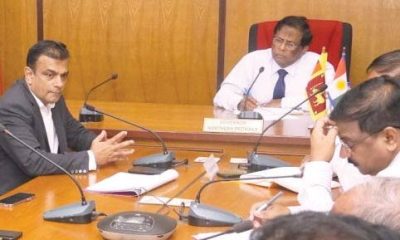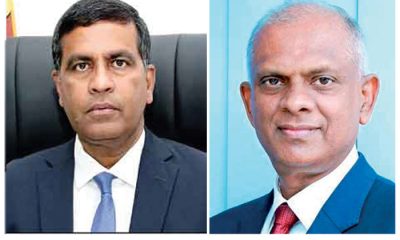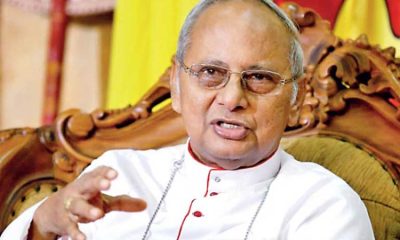Editorial
Cost puzzles

Saturday 8th February, 2025
The government has not yet disclosed its costing formula for paddy. It only releases information about cost calculations in dribs and drabs in an unorganised manner, which has left the public none the wiser. Farmers insist that their production costs are much higher than the guaranteed prices announced by the government; some of them have even claimed that the average certified paddy price should be above Rs. 140 a kilo.
Deputy Minister of Agriculture Namal Karunaratne told Parliament yesterday that the guaranteed prices of paddy had been properly worked out, and they included a 30% profit margin. The production cost of red kekulu paddy was only Rs. 76, and the farmers of that variety of rice earned a profit of Rs. 44 per kilo, he said. Interestingly, the guaranteed price of red kekulu paddy has not been specifically mentioned in government communiques on guaranteed paddy prices. Karunaratne also claimed that it cost farmers only Rs. 91 to produce a kilo of white nadu paddy, which fetched Rs. 120 although its actual cost plus the 30% profit amounted to only about Rs. 118. But paddy farmers say their production costs are much higher.
How can there be such vast cost discrepancies? Who is telling us the truth—the paddy farmers or the government politicians/officials? Will the two sides present itemised cost estimations for the public to decide whose claims are credible? The current cost calculations lack transparency and credibility. Most of all, on what basis was the 30% profit margin for paddy determined? Was it just plucked out of the air?
Deputy Minister Karunaratne told Parliament yesterday that in calculating the paddy production costs, the fertiliser subsidy had not been taken into consideration. The government ought not to ignore such vital factors when costs are estimated. The public, who bears the cost of fertiliser subsidy, must not be made to pay higher prices for rice unfairly.
Going by Deputy Minister Karunaratne’s statements at issue, the government can be accused of having facilitated the exploitation of the red rice consumers by placing the profit margin for the growers of that variety of rice far above the stipulated 30% level. The government should have taken steps to ensure that at least one variety of rice was reasonably priced for the benefit of the ordinary people who are getting by on shoestring budgets. It would also have been politically wise for the government to do so ahead of the local government elections slated for late April.
Subsidies for farmers could be considered an investment in the agricultural sector, for they help incentivise cultivators and keep production costs low. The government is duty bound to ensure that the benefits of subsidies accrue to the public, who bears the cost of them. Therefore, the fertiliser subsidy, or at least a part thereof, should have been factored in when the paddy production costs were calculated.
How does the government propose to prevent rice millers from making unconscionable profits? They have benefited from a 30% power tariff reduction, which must be passed on to the public. Rice wholesalers and retailers must also be prevented from fleecing the public. The government, which has failed to protect rice consumers against rapacious businesses bent on exploiting them, should get its act together.
Editorial
Trump’s shockers

Friday 7th February, 2025
President Donald Trump has apparently inherited from his father a propensity to acquire real estate. What he did as a real estate tycoon before becoming the US President has not caused much concern to anyone except some of his political rivals, but the problem is that old habits die hard; he, even as the US President, has not stopped eyeing land that belongs to others.
President Trump has expressed his desire to acquire Greenland. He is apparently dreaming of something like the Louisiana Purchase (1803), the greatest land bargain in US history. He has also disclosed his intention to take over the Panama Canal. Another shocker came on Tuesday, when he revealed a plan for the US to take over and own Gaza, resettling the Palestinians living there in neighbouring countries. Thankfully, all Arab states and even the western allies of the US have condemned Trump’s idea.
Gaza belongs to Palestinians, and the world must oppose any plan to dispossess them of their land. President Trump has brought shame on the US by seeking to capitalise on the misery of Palestinians who have undergone untold suffering for decades. The least the world can do for those people crying out for justice is to ensure that the UN-sanctioned two-state solution is implemented without further delay. One can only hope that the fragile Gaza ceasefire will hold, with Hamas and Israel acting with restraint, and that the West Bank will not face the same fate as Gaza.
The White House has sought to walk back Trump’s absurd idea of taking over Gaza. It has claimed that Trump has only suggested temporary resettlement of the Palestinians pending reconstruction. No matter how hard the White House spin doctors try, they will not be able to unsay what Trump said very unequivocally.
Trump has not started wars, and he deserves praise for that, but one wonders whether he is trying to make America great again by taking advantage of the US-backed wars and their disastrous consequences. Israel would not have been able to reduce Gaza to rubble without US backing. Ukraine would not have provoked Russia into a war but for assurances from the US and other NATO members that they would stand solidly behind it. Now, Trump is eyeing land in Gaza and rare earths in Ukraine. One is reminded of the bloody conflicts in some African countries which have many terror groups secretly funded by certain multinationals plundering their minerals. The Democratic Republic of Congo has been plagued by armed conflicts mostly due to power struggles over mineral resources, especially coltan used in producing mobile phones, laptop computers and automobiles. It is protracted violent conflicts claiming many lives that ensure a steady supply of coltan at cheap prices to the West.
President Trump has said the US will stop pouring dollars into a bottomless pit that is the ongoing Russia-Ukraine war. He has told Ukrainian President Volodymyr Zelensky in no uncertain terms that the US wants Ukraine to supply it with rare earth minerals in return for financial support. Ukraine is agreeable to his proposition, according to Trump. This is the price Ukraine has had to pay for its efforts to join NATO at the behest of the US and its western allies and antagonising Russia in the process. Hereafter, Zelensky will have to dispose of his country’s rare earths to fight NATO’s proxy war! Unless the other NATO members increase military aid to Ukraine, he will be in serious trouble economically, militarily and politically. Even during the Biden administration, when the US allocated funds generously for Ukraine’s military operations, Zelensky went around the world, complaining that support from his allies was woefully inadequate.
It is now clear that Trump’s second presidential terms will be much more problematic than the first one. He has also suspended US assistance to the developing world granted through the USAID. What other shockers Trump has up his sleeve is anyone’s guess.
Editorial
Challenge of being NPP govt.

Thursday 6th February, 2025
The JVP-led NPP government has announced certified prices of paddy at long last. Minister of Agriculture K. D. Lalkantha said yesterday that the Paddy Marketing Board (PMB) would purchase nadu, samba and keeri samba varieties at Rs. 120, Rs. 125 and Rs. 132 a kilo, respectively. Curiously, there was no mention of a certified price of red/white kekulu paddy.
Announcing the certified prices at which the PMB intends to purchase paddy is one thing, but purchasing paddy, as promised, is quite another. Does the PMB have enough storage facilities to maintain adequate stocks of paddy, which the government says, will be milled and sold to the public to prevent market manipulations by unscrupulous millers? Complaints abound that many PMB warehouses are still in a dilapidated state.
Farmers’ associations have taken exception to the certified paddy prices announced by the government. They are demanding higher purchase prices. But the government has to look at the bigger picture and factor in the interests of rice consumers as well when certified paddy prices are determined. Balancing the competing interests of those two groups is no easy task, especially ahead of an election. The government ought to provide a detailed or itemised cost estimation so that one will be able to see if it has calculated the paddy production costs properly.
Why did the government take so long to announce the certified prices of paddy? It is being claimed in some quarters that about 25% of the paddy harvest had been gathered by Wednesday (05). Opinion may be divided on the amount of paddy so far harvested, but a large number of farmers had to dispose of their produce at prices ranging from Rs. 80 to 90 a kilo in several districts for want of guaranteed prices.
The government recently claimed that it had delayed the announcement of the guaranteed prices of paddy purposely for the sake of farmers, who, it said, were selling their produce at prices as high as Rs. 140 a kilo. But farmers have rubbished this claim; they have said none of them could sell their paddy at such high prices, and the delay on the part of the government only enabled a group of large-scale millers with political connections to purchase paddy at unconscionably low prices. They have alleged that the government waited until the wealthy millers had finished purchasing paddy to announce the guaranteed prices. Successive governments have done so to enable the powerful millers to maximise their profits at the expense of both rice consumers and paddy cultivators. Whether the incumbent administration will be able to convince the public that it is different from its predecessors remains to be seen.
The onus is on the warring farmers’ associations and the Opposition, which is shedding copious tears for rice growers for political reasons, to prove that there arose a genuine need for higher guaranteed prices of paddy than the ones that prevailed before last year’s regime change; they should prove that the cost of producing a kilo of paddy has increased since September 2024 or so, when the average price of a kilo of rice was about Rs. 170. Were the increases in rice prices during the past several months due to an actual increase in the cost of production? Or, were they due to other factors such as hoarding by large millers? The Opposition, which demands a purchase price of at least Rs. 140 per kilo of paddy, has attributed the steep hikes in rice prices to a secret deal between the big-time millers and the government, hasn’t it? How will it reconcile the aforesaid allegation with its claim that the cost of producing paddy has increased?
Meanwhile, the government has said the certified prices of paddy are aimed at maintaining the maximum retail prices of rice at the current level while looking after the interests of the farmers. The public has been protesting against the prevailing rice prices, which they consider extremely high. Is it that the government has no plans to bring down the rice prices to the previous levels?
Editorial
Rice-paddy dilemma

Wednesday 5th February, 2025
Rice is more than a food item for Sri Lankans; it is a kind of politico-cultural staple. Hence its ability to make or break governments. One of the key factors that led to the 1953 Hartal was a steep rise in the price of rice under a UNP government. The then Prime Minister Dudley Senanayake had to resign when protests went out of control. The SLFP-led United Front government came to power in 1970, promising to make rice freely available at affordable prices even if it were to be brought from the moon, of all places! However, that promise went unfulfilled, and rice shortages, among other things, led to the collapse of that dispensation.
Interestingly, an increase in the price of rice due to a subsidy cut, inter alia, under another UNP government, gave a big fillip to the early growth of the JVP as an alternative to the traditional leftist parties in the late 1960s. About six decades on, a democratically elected JVP-led government is facing a kind of existential problem over some unresolved issues concerning rice. It is a double whammy for the JVP; both rice consumers and paddy farmers are demanding that their competing interests be addressed.
Rice growers are threatening to march on Colombo and stage what they call Aragalaya II unless the government ensures that they get a fair price for their produce without further delay. They have been berating the government for serving the interests of some wealthy millers at the expense of the farming community. The Opposition, true to form, is fishing in troubled waters.
Opposition Leader Sajith Premadasa has been urging the government to set the guaranteed price for paddy at Rs. 140 a kilo. If the government acceded to his demand, how much would a kilo of rice be? Will Premadasa provide an answer?
True, the government is seen to be serving the interests of some big-time millers, who always have the last laugh. People voted the JVP-led NPP into office because they wanted it to deal firmly with all those who were exploiting them. The government has baulked at taking on the millers. However, its difficulties should be appreciated. It is in a Catch-22 situation. It cannot increase the purchase price of paddy without causing the rice prices to increase. Similarly, it cannot bring down the rice prices without lowering the paddy prices.
The government is in the current predicament because it is dogged by the slogans the JVP/NPP used during its opposition days to mobilise farmers against the previous administration. When current Deputy Minister of Agriculture Namal Karunaratne was in the opposition, he pressured the SLPP-UNP government to ensure that paddy fetched Rs. 150 a kilo. Now, he is drawing heavy flak from his erstwhile fellow agitators, who are demanding that the NPP government carry out what it asked its predecessor to do.
It behoves the government and agricultural experts to get their costing right. The average price of rice was about Rs. 170 per kilo when the NPP came to power late last year. The purchase price of paddy was below Rs. 100 per kilo at that time. Rice growers demanded higher prices for their produce, but they reconciled themselves to the market conditions, the implication being that they were either breaking even or earning profits at least marginally; otherwise, they would have taken to the streets, led by the JVP/NPP. The average price of rice increased beyond Rs. 250 per kilo subsequently and the government moved in to cap it at Rs. 230. Has the cost of producing paddy increased steeply since last year’s regime change for the protesting farmers to demand an increase in the purchase price of their produce?
It is only natural that farmers strive to get the highest possible price for their produce, but cost calculations should be done scientifically for a guaranteed price for paddy to be determined. The government should pluck up the courage to stop dilly-dallying and grasp the nettle. Procrastination will only make matters worse.
-

 News6 days ago
News6 days agoNew Bangalore-Jaffna flights in the works
-

 News4 days ago
News4 days agoCID questions top official over releasing of 323 containers
-

 News6 days ago
News6 days agoCardinal says ‘dark forces’ behind Easter bombs will soon be exposed
-

 Features5 days ago
Features5 days agoA singular modern Lankan mentor – Part II
-

 News6 days ago
News6 days agoHRCL reports on Rohingya asylum seekers
-

 News1 day ago
News1 day agoMusk reveals ‘crazy waste’ of USAID funds in Sri Lanka
-

 Features5 days ago
Features5 days agoBharath Rang Mahothsav Parallel Festival in Colombo
-

 News6 days ago
News6 days agoIshadi Amanda makes history as First Runner-Up at 40th Mrs. World Pageant











